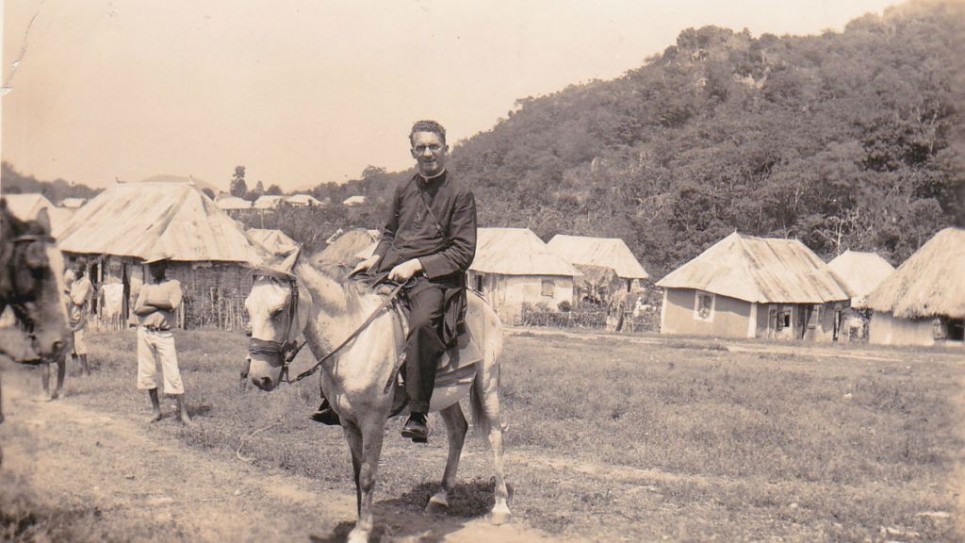

DUBLIN As the Gestapo surrounds the palace of an Italian anti-Fascist aristocrat, an Irish priest dashes to the cellar. He is wanted by the Nazis for his role in the daring rescues of Jews, POWs and refugees, but this time it seems there is no escape. Miraculously, a coal delivery being made to the palace offers the perfect cover the cleric blackens his face, hides his cassock and slips away to freedom through the narrow cobbled streets of Rome.
This dramatic scene, recreated in the 1983 movie "The Scarlet and the Black" starring Gregory Peck as Monsignor Hugh 'Flaherty, was just one of a number of close shaves for the doughty Irish priest and Vatican diplomat during his heroic campaign to thwart the Gestapo in the Eternal City during World War II.
"Monsignor O'Flaherty left the safety of the Vatican to run his escape line," said Jerry O'Grady, chairman of the Monsignor Hugh O'Flaherty Memorial Society in the priest's hometown in Killarney, Ireland. "The Gestapo had a price on his head and they tried to kidnap him many times."
The Society is now preparing an application to Yad Vashem to have their local hero, who is credited with concealing hundreds of Jews from the Gestapo, listed as Righteous Among the Nations.
Flaherty grew up the son of a golf steward in Killarney, Ireland, and his skill at the game helped ease his way into Roman society. The priest played with social luminaries such as Mussolini’s son-in-law Count Galeazzo Ciano, as well as the former Spanish King Alphonso. All his connections were to become very useful when he took on the unforeseen mantle of rescuer. In the last years of the war, as the Italian government collapsed O’Flaherty organized a group of priests, anti-Fascist and diplomats to help shelter Jews, escaped POWs and refugees. He set up a network of safe havens in rented apartments and religious houses throughout Rome. Claudio-Ilan Jacobi, now living in Israel, is one of the Jews O'Flaherty saved. He was away from the ghetto when the Gestapo raided it. "I saw the Monsignor many times," Jacobi wrote in his statement for Yad Vashem. "He helped my mother, my grandparents and me find refuge from the Nazis." "He got false papers for us from the Vatican as well as food cards," Jacobi said. "I remember the great appreciation my mother had for all he did." On one occasion O'Flaherty even threatened the doorman of Jacobi's apartment with excommunication for speaking too freely about the Jewish family hiding inside.
"The test for recognition by Yad Vashem is very rigorous," said O'Grady, "so we are continuing to try to trace Jewish survivors or their families from the city." As the Nazis began transporting Roman Jews to the camps, O'Flaherty walked Ines Ghiron and her friends through the Gestapo-filled streets relying on false Vatican papers for safe passage. Ghiron wrote in her memoirs that they all arrived safely at a convent in Monteverde run by Canadian nuns. Another such episode was recorded by Jewish POW John Furman, whom O'Flaherty hid for months. The British Lieutenant wrote in his autobiography that he never looked on O'Flaherty as a priest, but as a friend who made other people's troubles his own. After the Gestapo became aware of O'Flaherty’s activities they painted a white line across St. Peter's Square, dividing the neutral Vatican from Fascist-controlled Rome. They placed guards nearby ready to snatch the Monsignor if he ever crossed. As a result O'Flaherty became known locally as the Scarlet Pimpernel because of the many disguises he donned during his forays into the capital.
The modest monsignor only came to public attention in the 1960s when books about his exploits were published.
"Monsignor O'Flaherty has already been honored by the American, British and Italian governments," said O'Grady. "He received the Commander of the British Empire (CBE) and the US Medal of Freedom but he has never been officially recognized by the State of Israel." Holocaust survivor Tomi Reichental, who was the keynote speaker at the 2013 Annual Humanitarian Award named in honor of O'Flaherty, told The Times of Israel that "If he saved one Jew it's as if he saved thousands."
The New York Jewish Museum has organized trips to visit Ireland's historical and scenic highlights, and describes O'Flaherty as "Ireland's Oskar Schindler." The museum includes a visit to his hometown in their itinerary.
In 2013 the Monsignor Hugh O'Flaherty Society erected a life size bronze statue in his honor. The unveiling was attended by former Israeli ambassador Boaz Moda'i. The memorial bears O'Flaherty’s personal motto, "God has no Country."
"Monsignor O'Flaherty was an Irish Republican, but when he saw how the Nazis were treating the Jews he knew which side he had to be on," explained O'Grady. "That's where his motto originated."
After the war Gestapo colonel Herbert Kappler, who tried to capture and kill O'Flaherty, was convicted of war crimes and sentenced to life in prison. True to his own nature, however, O'Flaherty visited him many times and the Nazi later converted to Catholicism.
O'Flaherty suffered a stroke in 1959 and retired to live with his sister in Kerry. He died in 1963 just as his exploits were becoming the stuff of legend.
Contact
Kenneth Gallaher
P.O. Box 172 Dumaguete City 6200 Negros Oriental Philippines
Phone 092666888266
email-gallkr1@gmail.com